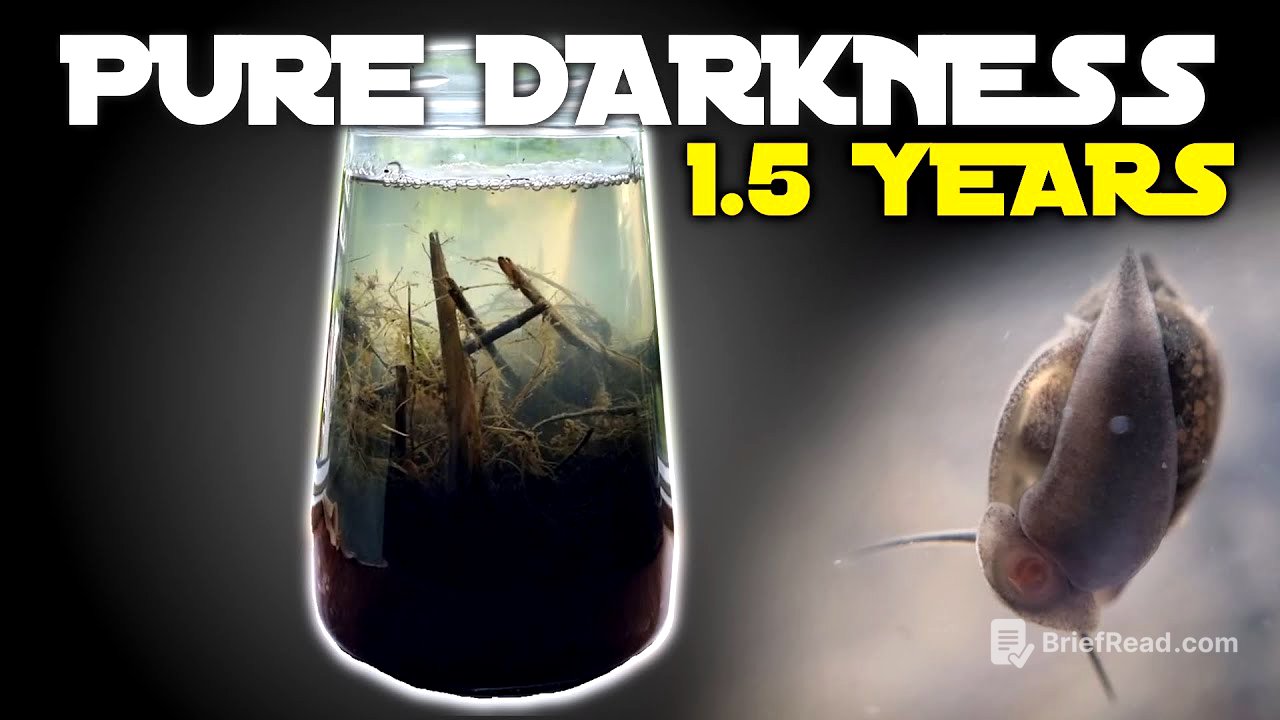TLDR;
This video explores a closed ecosystem in a jar that has been kept in complete darkness for a year and a half. It documents the changes in the ecosystem's inhabitants, including the survival and decline of various species, the emergence of bacterial growth, and the overall resilience of certain organisms like bladder snails and scuds. The video also touches on the limitations of such an ecosystem due to the lack of light and primary production, and poses questions about its long-term survival and potential response to light exposure.
- The ecosystem was created with sediment from an existing environment but without plants.
- Key inhabitants included worms, gammarids (scuds), midge larvae, bladder snails, limpets, daphnia, copepods, diatoms, ciliates, and various microbes.
- Over time, some species thrived (bladder snails, scuds), while others disappeared (limpets, daphnia, copepods).
- The ecosystem showed signs of anaerobic activity and bacterial growth, with a biofilm forming on the glass.
- The video raises questions about the long-term sustainability of the ecosystem without light and primary production.
Ecosystem Setup and Initial Inhabitants [0:25]
The experiment began by placing a portion of an existing ecosystem into a jar. Unlike typical setups, no plants were added, as they were expected to die quickly in darkness. The jar was left open to allow for oxygen exchange, creating an environment where animals could potentially survive without light. Initial inhabitants included a mysterious worm (possibly Oligochaeta, Tubificida), gammarids (scuds), chironomid midge larvae, bladder snails (Physa fontinalis), limpets, daphnia, copepods, diatoms, and various microbes and ciliates.
First Week of Darkness [3:14]
After one week in darkness, the ecosystem showed signs of anaerobic activity, indicated by gas bubbles in the sediment. Despite the lack of light, bladder snails were thriving and laying eggs, and baby gammarids had hatched, filling the jar. Daphnia and copepods were also reproducing. Diatoms were still present, though the largest one was missing. Smaller, faster-moving ciliates were observed, but larger species from the previous week were not found.
Six Months of Darkness [4:56]
After six months, the water level had significantly decreased due to evaporation. Most of the plant material had been broken down by detritivores, forming a layer of pulp on top of the sediment. The sediment remained anaerobic. Gammarids (likely Gammarus pulex) were still present, and bladder snails (possibly Physella acuta rather than Physa fontinalis) were also surviving. Copepods were observed, but daphnia were absent, possibly due to their greater reliance on microscopic algae. The worms were still present, creating tunnels in the sediment.
Fourteen Months of Darkness and Drought [10:21]
After another eight months, the jar had experienced a period of drought, with all the water above the sediment evaporating. Despite this additional stressor, bladder snails continued to survive. The snails had become darker, possibly as an adaptation to the dark environment. A greenish growth, potentially algae, was observed on the glass, despite the lack of light. This growth appeared to be grazed upon by the snails. Scuds were also still present, exhibiting cannibalistic behavior.
Decline of Species and Microbial Analysis [14:22]
Limpets had disappeared from the ecosystem, likely due to their diet of diatoms that grow on plants, which were absent in the jar. Daphnia and copepods were also gone, possibly due to the lack of algae and predation by gammarids. The mystery worms were not observed, but may have been buried in the sediment. Microscopic analysis revealed the presence of dead diatom frustules and a large number of bacteria and archaea. Paramecium, a type of ciliate that feeds on bacteria, were also present.
Conclusion and Future Directions [18:29]
The ecosystem had survived in complete darkness for a year and a half, demonstrating the resilience of certain organisms. However, the lack of light and primary production limits the ecosystem's lifespan due to the absence of new food and energy sources. Future research could explore the ecosystem's long-term survival in darkness or its response to a sudden exposure to a day-night cycle.









